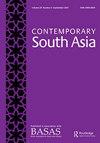平台化时代印度唱片业的形态变化
IF 0.8
3区 社会学
Q3 AREA STUDIES
引用次数: 1
摘要
摘要学者们探讨了数字化之前和当代音乐流媒体平台时代,技术发展对音乐家生计的影响。然而,在印度音乐产业方面存在着显著的差距,而文化工作方面的学术界却明显忽视了这一点。本文有助于解决这一差距。首先,我们展示了平台化是如何挑战电影配乐对印度音乐的长期统治的,电影配乐使非电影音乐家的职业生涯岌岌可危,工作不可持续。我们表明,平台化带来了新一轮非电影音乐浪潮,对电影音乐的文化霸权提出了前所未有的挑战。其次,我们展示了平台化也加速了版权改革的需求,这可能会让一些音乐人受益。然而,第三,我们表明,平台化很可能会加强强大的本地唱片公司的统治地位,对音乐家产生潜在的负面影响。第四,我们认为,平台化可能会对那些使用印地语和英语之外的主流语言工作的音乐家不利。我们的结论部分表明,平台化给一些音乐家带来了挑战和潜在的好处,并对未来文化作品平台化的研究提出了启示。本文章由计算机程序翻译,如有差异,请以英文原文为准。
The changing shape of the Indian recorded music industry in the age of platformisation
ABSTRACT Scholars have explored the impact of technological developments on the livelihoods of musicians before digitalisation and in the contemporary age of music streaming platforms. However, a striking gap exists with respect to the Indian music industries which have been conspicuously ignored by scholarship on cultural work. This article contributes towards addressing this gap. First, we show how platformisation is challenging the longstanding domination of Indian music by film soundtracks which relegated non-film musicians to precarious careers with unsustainable work. We show that platformisation has ushered in a new wave of non-film music that is posing unprecedented challenges to the cultural hegemony of film music. Second, we show how platformisation has also accelerated demands for copyright reform, which may benefit some musicians. However, third, we show that platformisation may well reinforce the domination of powerful local record companies, with potentially negative impacts on musicians. Fourthly, we suggest that platformisation may be disadvantaging musicians who work in languages besides the dominant ones of Hindi and English. Our concluding section suggests that platformisation brings both challenges and potential benefits for some musicians and draws out the implications for future research on the platformisation of cultural work.
求助全文
通过发布文献求助,成功后即可免费获取论文全文。
去求助
来源期刊

Contemporary South Asia
AREA STUDIES-
CiteScore
2.10
自引率
0.00%
发文量
82
期刊介绍:
The countries of South Asia - Bangladesh, Bhutan, India, Maldives, Nepal, Pakistan and Sri Lanka - are internally diverse and part of global flows of people, goods and ideas. Contemporary South Asia seeks to address the issues of the region by presenting research and analysis which is both cross-regional and multi-disciplinary. The journal encourages the development of new perspectives on the study of South Asia from across the arts and social sciences disciplines. We also welcome contributions to pan-regional and inter-disciplinary analysis. Our aim is to create a vibrant research space to explore the multidimensional issues of concern to scholars working on South Asia and South Asian diasporas in the postcolonial era.
 求助内容:
求助内容: 应助结果提醒方式:
应助结果提醒方式:


